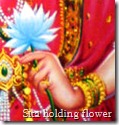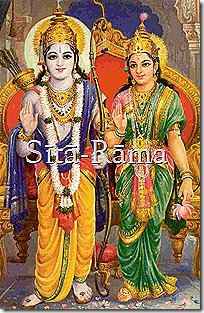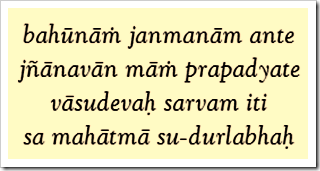 “This
is Sita, who is firmly dedicated to her husband and is the daughter of
the great soul Janaka, who is the King of Mithila and strictly adherent
to religious principles.” (Hanuman, Valmiki Ramayana, Sundara Kand,
16.15)
“This
is Sita, who is firmly dedicated to her husband and is the daughter of
the great soul Janaka, who is the King of Mithila and strictly adherent
to religious principles.” (Hanuman, Valmiki Ramayana, Sundara Kand,
16.15)
iyam sā dharma śīlasya janakasya mahātmanaḥ |
sutā maithilarājasya sītā bhartṛdṛḍha vratā ||
sutā maithilarājasya sītā bhartṛdṛḍha vratā ||
For
those who are not familiar with the Ramayana and its characters, who
are real-life historical personalities, from this verse they can learn
about one of them: Sita Devi. The ancient scriptural texts of India were
composed by sages out of a desire to spread the glories of the Supreme
Lord to others. The act itself is known as kirtanam, or
describing, and it is a way to simultaneously realize God at the
personal level. Due to the influence of Kali Yuga, the dark age of
quarrel and hypocrisy, fools and cheaters give their own interpretations
to the texts while ignoring the authentic message. Here Shri Hanuman
gives us another definitive truth from the Ramayana, leaving no room for
doubt.
What are some of the misinterpretations?
The
Ramayana gets its name from the lead character, Shri Rama. As a
Sanskrit word, His name means one who gives transcendental pleasure or
one who holds all transcendental pleasure. This word Rama is one way to
address God, and Shri Rama the historical figure is a non-different
expansion of the Supreme Lord. These facts aren’t concocted by the
author. They are presented clearly in the Ramayana itself. Indeed, we
only know of Rama’s existence from the Vedic texts, which all speak to
His being God. Any other interpretation of Rama is therefore incorrect.
One
of the bogus interpretations says that the Ramayana refers to the
“Rama” within all of us. Following that, Sita, Rama’s wife, represents
something else about us, and Lakshmana, Rama’s younger brother, again
something else. Shri Hanuman, the greatest servant of the trio,
represents another personal aspect. This is the result of mental
speculation, as nowhere in the Ramayana is any of this said, and indeed
all the verses speak to real personalities, who travelled to real places
that one can locate to this day inside of India and neighboring areas.
In other Vedic texts the same pastimes are described in varying levels
of detail, and in all of those texts Rama’s divinity is confirmed.
 In
this verse from the Ramayana Shri Hanuman confirms to himself that he
has spotted Sita. Hanuman is in a grove of Ashoka trees inside of the
kingdom of Lanka, which was presided over at the time by the Rakshasa
king Ravana. Hanuman doesn’t say that he has found the material body or
the “Sita” within. He refers to Sita by her identifiable features, which
are perceivable and understandable to the sober person who has no
intention of twisting the truth to suit their personal needs.
In
this verse from the Ramayana Shri Hanuman confirms to himself that he
has spotted Sita. Hanuman is in a grove of Ashoka trees inside of the
kingdom of Lanka, which was presided over at the time by the Rakshasa
king Ravana. Hanuman doesn’t say that he has found the material body or
the “Sita” within. He refers to Sita by her identifiable features, which
are perceivable and understandable to the sober person who has no
intention of twisting the truth to suit their personal needs.
It
was custom in ancient times for a person to be identified by their
parents. Today when someone asks for identification, they look at a
government approved card that has our picture on it. The driver’s
license and passport have our picture, our address, and our name. They
also have our date of birth. The relationship to the parents is not
required; as the approved form of id is enough for the authenticating
party to verify identity.
In
times past, the form of identification was the relationship to the
parents. In this instance, Sita is identified through her relation to
Janaka. And who is Janaka? Hanuman says that Janaka is a great-soul, or
mahatma. The word “mahatma” is a compound word consisting of “maha” and
“atma”. “Maha” means great and “atma” means soul. Atma can also mean
body or mind, but in this context it means soul. Of course we can say
that anyone is a great soul. No one has any real authority in this
matter, as what we call someone else is completely up to us.
Hanuman
gives evidence for why Janaka is a mahatma. Hanuman says that Janaka is
strictly adherent to religious principles, or dharma. The material and
subtle bodies are maintained through action in dharma, or religious
principles, for the purpose of reaching the pinnacle of action, which is
devotional service. Every soul’s constitutional position is lover of
God, but in the conditioned state one is unaware of this fact. As Lord
Krishna, the same Rama but in His original form, says in the
Bhagavad-gita [7.19], it takes many, many lifetimes for a person to
finally surrender to God in earnest and become a devotee.
“After many births and deaths, he who is actually in knowledge surrenders unto Me, knowing Me to be the cause of all causes and all that is. Such a great soul is very rare.” (Lord Krishna, Bhagavad-gita, 7.19)
In
the meantime, the principles of dharma allow one to progress to that
rare state of love for God in full surrender. The king is the upholder
of dharma; he maintains adherence to religious principles in society by
first following them himself. His occupational duties as a kshatriya, or
one in the royal order, include protecting the innocent against
aggressors, following the advice of the priestly class, and collecting
taxes in order to maintain a good government. Janaka was known
throughout the world as a king who followed dharma. He ruled over the
kingdom of Mithila, a factual area that still exists to this day.
Sita
is the daughter of that great-soul, giving us one way to identify her.
The relationship to Janaka is one based on body, and next Hanuman
identifies Sita based on action. She is unswerving in her devotion to
her husband. This has double significance here. For a woman who follows
Vedic principles, her primary duty in adult life is to serve her husband
with dedication. This is her dharma, which is just below devotional
service. Following dharma for the sake of abiding by duty is action in
the mode of goodness, which eventually turns into bhakti, or love for
God, when the attachment to the results is discarded. When lacking
bhakti, the wife’s fate is tied to the husband; she goes wherever he
goes in the afterlife.In Sita’s case, however, the husband was the Supreme Lord. This automatically made her dharma fall into the category of bhakti. In devotional service, the end result is always association with God in some way. Sita is always with Rama, though the two might not always be within the same physical proximity. In this case Sita was separated from Rama, and Hanuman was sent to find her on Rama’s behalf. Upon first sight Hanuman accurately identified her for both himself and the future generations who would delight in the sacred nonfictional tale that is the Ramayana.
In Closing:
From Hanuman’s words get a feel,
For Sita, character from Ramayana real.
Not a figment of the imagination,
Or aspect of body representation.
By relationship to father Janaka she is identified,
With respect for dharma over kingdom he did preside.
Also known as Shri Rama’s beloved wife,
Service to Him her dharma in life.
From the speculating cheaters stay away,
And instead listen to what Hanuman does say.
 “After
many births and deaths, he who is actually in knowledge surrenders unto
Me, knowing Me to be the cause of all causes and all that is. Such a
great soul is very rare.” (Lord Krishna, Bhagavad-gita, 7.19)
“After
many births and deaths, he who is actually in knowledge surrenders unto
Me, knowing Me to be the cause of all causes and all that is. Such a
great soul is very rare.” (Lord Krishna, Bhagavad-gita, 7.19)
No comments:
Post a Comment